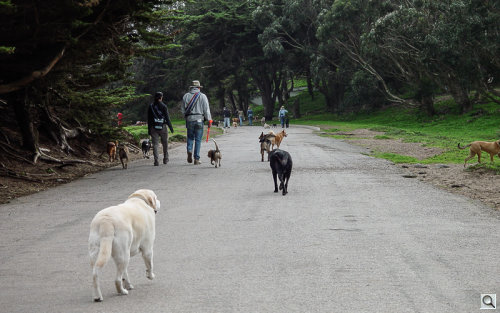Photo Corners headlinesarchivemikepasini.com
![]()
A S C R A P B O O K O F S O L U T I O N S F O R T H E P H O T O G R A P H E R
![]()
Enhancing the enjoyment of taking pictures with news that matters, features that entertain and images that delight. Published frequently.
Friday Slide Show: Fort Funston




20 February 2015
South of the long, three-mile Ocean Beach on San Francisco's western side, Fort Funston is something of a secret. That was fine when it served as a military installation, hiding Nike missiles. But it's really too spectacular to keep secret.
The views from the 200-foot bluffs are stunning. And there really isn't much military concrete to get in the way. Long staircases take you down to the beach (but there are no elevators to get you back up).
There are trails all over the bluffs. You can park in the dirt shoulder of Highway 35 below a sandy trail that goes uphill into the fort. It's just across the left turn signal to John Muir Drive that follows Lake Merced. Or you can park in a lot just a little further south with all the hang gliders.
There's a lovely little wooden lookout just off the parking lot, by the way.
Fort Funston is open for on-leash and voice-control dog walking, meaning the dogs you run across on the beach and on the trails are almost all off-leash.
And there are a lot of dogs. It's something of an Olympic Club without dues for dog owners, all of whom seem to know each other. It's also the equivalent of a business district for dog walkers. And the dogs do indeed do their business there, so watch your step.
If you aren't a dog lover, you can scratch this place from your list but otherwise it's really not to be missed.
These images were shot 10 years ago this month using a Sony CD Mavica MVC-CD400, a bulky 4-megapixel camera with a 3x Carl Zeiss Vario Sonnar optical zoom lens with a 34-102mm equivalent range that writes its 2272x1704-pixel JPEGs to 156-MB 3.0-inch CDs to store images. It sold for $899 when it was released in 2002.
We shot JPEGs (the only option) with both optical and digital zoom (the almost monochromatic image of a ship and the Farallon Islands is the only digital zoom image). ISO was 100 for all of these (the camera only went to 400) and aperture varied from f4 to f8. Shutter speed varied from 1/125 to 1/500 as well as Program mode dealt with the clouds passing by.
But the real challenge was white balance. It was all over the place, which is why we've been skipping over these images as candidates for our slide shows.
But Lightroom came to the rescue. We established a base white balance we applied to all of the images and tweaked both the Temperature (which needed to be a bit cooler) and Tint (which needed a bit more magenta).
We did try the trick Scott Kelby's trick of creating white balance presets from a Raw file to use on JPEGs but they just didn't get us as far as we had to go.
At the 34mm equivalent focal length, the horizon suffered from noticeable barrel distortion. It looked like the curvature of the earth, in fact. So we straightened it out manually (Lightroom knows nothing about the lens, in part because the Exif data is rudimentary, not even mentioning the camera model).
We also did a little rotation and cropping of the original captures. And, as usual, played with the Basic settings, adding Clarity and, for a change, some Contrast. We also knocked the Saturation down a bit. There wasn't the usual elbow room of a Raw file for these JPEGs but they could be persuaded just the same.
All of which suggests (if it doesn't prove) that a modern image editor can salvage 10 year old sensor captures.
Our last shot is the only one looking east. We were standing on the trail we can see from our dining room window (the place we take our sunset shots) and looking back. Our window is a pixel in there somewhere.
